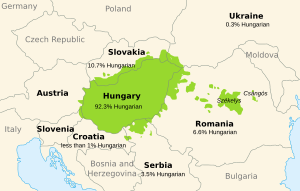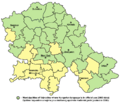Hungarian language facts for kids
Quick facts for kids Hungarian |
|
|---|---|
| magyar | |
| Native to | Hungary and areas of Austria, Croatia, Romania, Serbia, Slovakia, Slovenia, Ukraine |
| Native speakers | 14–15 million (2005) |
| Language family |
Uralic
|
| Writing system | Latin (Hungarian alphabet) Hungarian Braille |
| Official status | |
| Official language in | |
| Recognised minority language in | |
| Regulated by | Research Institute for Linguistics of the Hungarian Academy of Sciences |
| Linguist List | ohu Old Hungarian |

Regions of the Carpathian Basin where the Hungarian language is spoken
|
|
Hungarian is a unique language spoken mainly in Hungary. People who speak it call it Magyar. It belongs to a special group of languages called Uralic languages. Other languages in this family include Finnish and Estonian.
Unlike most languages in Europe, Hungarian is not an Indo-European language. However, it has borrowed many words. These words come from languages like Slavic, Turkic, and German.
Contents
Who Speaks Hungarian?
Around 13 million people speak Hungarian. Most of them live in Hungary, about 10 million. Another 1.5 million speakers live in Romania. You can also find Hungarian speakers in Slovakia, Serbia (especially in a region called Vojvodina), and Ukraine.
Hungarian is the official language of Hungary. It is also one of the official languages of the European Union (EU). In some areas, like Vojvodina in Serbia and parts of Slovenia, Hungarian is also an official language.
Hungarian Dialects
Hungarian has several different ways of speaking, called dialects. But don't worry, speakers of different dialects can usually understand each other easily. One special dialect is the Csángó dialect in Romania. This dialect is older and has changed less over time than the others.
The standard Hungarian language you read in books is based on the Northeastern dialect.
How Hungarian Grammar Works
Hungarian grammar is quite different from languages like English.
No Grammatical Gender
One interesting thing is that Hungarian has no grammatical gender. This means there are no separate words for "he" or "she." Instead, there is one word, ő, that means both.
Suffixes Instead of Prepositions
Instead of using separate words like "from" or "with" (called prepositions in English), Hungarian adds small parts to the end of words. These are called suffixes.
- For example, "from Budapest" becomes Budapestről.
- "With Alexandra" becomes Alexandrával.
Vowel Harmony
Another cool feature is called vowel harmony. This means that suffixes change to match the vowels in the main word.
- If a word has "a" in it, the suffix will usually have "a" too. For example, fa (tree) becomes fával (with a tree).
- If a word has "e" in it, the suffix will change to have "e." For example, teve (camel) becomes tevével (with a camel).
Word Accent
In Hungarian, the accent (or stress) is always on the first syllable of a word. This makes it easier to know how to pronounce words.
Writing in Hungarian
The Hungarian alphabet uses the Latin alphabet, just like English. However, it has more letters. Some letters have special marks above them, called diacritics. Because of these, Hungarian has 44 letters, which is more than the 26 letters in English.
Hungarian writing is mostly phonetic. This means that if you know how a word sounds, it's usually easy to write it down.
A Look at Hungarian History
The very first Hungarian words we know of were found in a Latin document. This document was the Foundation Charter of the Abbey of Tihany, written in 1054. The oldest full Hungarian texts are the Funeral Oration and Prayer (from 1192-95) and the Old Hungarian Lament of Mary (from the 13th century).
The first printed books in Hungarian appeared in the 16th century. The modern Hungarian language, as we know it today, developed in the 18th and 19th centuries.
Hungarian became the official language of Hungary in 1844. It replaced Latin, which had been the official language before.
Images for kids
-
The Bible translated into Hungarian.
See also
 In Spanish: Idioma húngaro para niños
In Spanish: Idioma húngaro para niños







